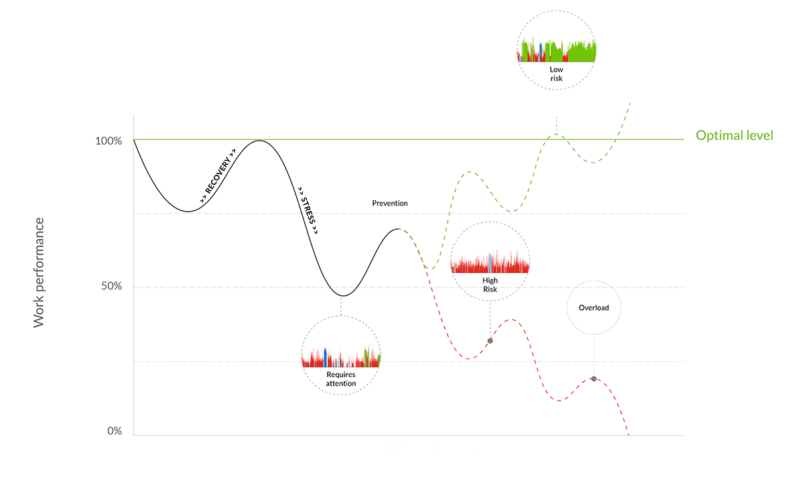
Presenteeism refers to lost productivity when an employee is working but not fully functioning. This may be due to, for example, illness, workload, or lack of motivation. Especially in the modern hybrid workplace, well-being and work performance can slowly deteriorate, unnoticed by the employer. Presenteeism is a critical issue for corporate wellness, but how do you manage and prevent it?
The core idea of presenteeism is that a person is physically present, but mentally absent or otherwise unable to work as normal. Performance and productivity are therefore lower than expected.
A concrete example of presenteeism is working while fatigued. If an employee constantly works while physically or mentally tired, productivity decreases significantly. If the situation continues for long, the cost of this lost labour input is high. Risks of other more serious consequences also grow.
It is recognised that in many companies presenteeism can be an even bigger and more expensive issue than absenteeism. In Finland, some estimates have assessed the costs of presenteeism for employers to be around 1600 € per employee per year. However, these numbers do not consider all aspects, such as the extra load that falls on colleagues. For the employees themselves, their well-being and enjoyment of life are also at risk, which are immeasurably valuable.
Determining the exact cost of presenteeism can be challenging. Many studies have used different calculations, focusing on, for example, a specific illness or condition that is causing presenteeism. Making comparisons between countries is also difficult due to the various ways of assessing presenteeism, as well as varying salary levels and living standards. However, the costs are generally high and often could be reduced through appropriate actions by the employer.

Picture: Employee’s performance and resources affect productivity. The earlier presenteeism and challenges are identified, the better the employer and employee can make the necessary changes to build better habits and prevent potential risks.
Reacting Is Not Enough – Prevention Is Needed
The traditional way to enhance corporate wellness and work performance has been about reacting to issues when they arise. However, this approach does not cut it anymore. With presenteeism, absences from work might not even occur. The employee can continue showing up to work while fatigued, depressed, or experiencing some type of physical pain.
Because presenteeism is such a common issue nowadays, finding ways to prevent and manage it can be a competitive advantage for companies. Employees with good well-being are usually also:
- more effective, productive and motivated, enabling them to achieve higher goals
- healthier, with fewer absences and lower health care costs
- more committed, leading to lower employee turnover
The problem is that identifying and measuring presenteeism can be tough. The management team and the human resource department must have the courage to reform and modernize the company’s corporate wellness actions if needed. Some organizational changes might also be in order. While this may require a lot of effort, the rewards can be profound.
Unfortunately, there is no quick fix for presenteeism. As with any other critical issue, preventing and managing presenteeism requires careful planning and persistent long-term effort. It comes down to building a sustainable organizational culture that supports employee well-being, as well as to choosing the right corporate wellness actions for your company.
Four Concrete Steps Employers Can Take to Help Prevent Presenteeism
1. Create a Solid Foundation for Employee Well-being
Assess your employees’ current level of well-being to identify the key challenges and to correctly set the targets for your corporate wellness activities. Keep in mind that your employees’ well-being at work is not merely affected by work-related factors, but also their personal life, such as their life situation, health, and lifestyle choices. It is all about the overall well-being of each individual.
Focus on the root causes behind presenteeism. Identify any challenges and risks at organizational and team levels. Having one-on-one discussions with your employees about presenteeism, wellness and work performance can be a good way to encourage them to bring up how they are doing. Through these discussions you are also enabling your employees to be part of positive change for the company.
2. Decide What Metrics to Use and How to Track Them
Anything that you can measure you can also monitor and develop. For presenteeism, you could utilize questionnaires and ask your employees, for example, to evaluate their own work performance, motivation and well-being. However, these are subjective and not necessarily the most accurate. It depends a lot on how well employees are able to assess their own situation, and how truthful they are in their answers.
Often the best way to get reliable data is to use objective metrics, such as physiological measurements. Physiological measurements provide you with accurate data on your employees’ well-being, both on the company and individual levels. For example, with Firstbeat Life you get company and group level reports that give you critical information on the key challenges, trends and potential risks within your company. With this data you are able to target supportive actions for the right people at the right time. No matter what your metrics are regularly monitoring them is key.
3. Abandon the “Hero Culture”
Make sure that your organizational culture actually encourages avoiding presenteeism. It is high time to abandon the so-called “hero culture’’ where employees come to work no matter how ill or exhausted and are praised for that. There is no job or career so important that one should sacrifice their well-being. There is also no employer who benefits from employees coming to work while sick or eventually burning out.
Be aware that even unofficial practises among the work community affect employees. It is important to make sure that you do not unintentionally create or reinforce a false narrative where employees who are constantly busy and even skip their breaks are in some way admirable. In reality, that type of behaviour eventually leads to presenteeism and possibly extended work absences.
4. Encourage Employees to Take Care of Themselves
Take actions to ensure your employees are able to properly look after their own well-being. The organizational culture should enable each individual employee to impact their wellness and performance every single workday. A culture that does not, for example, allow sufficient breaks or encourage taking time off can be very draining.
It is also important to create an atmosphere where employees feel safe enough to bring up possible issues about their well-being. Conversations around health and wellness should be kept alive. When employees know that they can get help and support, they are more likely to ask for it before the situation has gone too far.
Firstbeat Life is a corporate wellness solution designed to support employee health risk management and workplace health promotion. Improve efficiency, reduce health costs, build resilient workforce and create a caring work environment. Learn more about Firstbeat Life.
You might also be interested in

Firstbeat Life: How Do You Get Employees Engaged in Corporate Wellness?
When it comes to corporate wellness, one of the most common problems is getting employees engaged. So, what to do? Our specialist gives concrete tips, how to get employees commit to small changes.

Changes in Work Performance – Factors that Every Organization Should Consider
Employee’s work performance varies from year to year, month to month, changing almost cyclically. Our corporate wellness specialist Riikka Nahkamäki tells which factors cause these changes and how decreased performance can be improved.

Measuring Workplace Well-being: How to Set Goals and Utilize Data
Busy schedules, multitasking, blurring boundaries between work and leisure… To mention a few of the issues many employees are nowadays struggling with. In fact, the struggles of the employees are…

